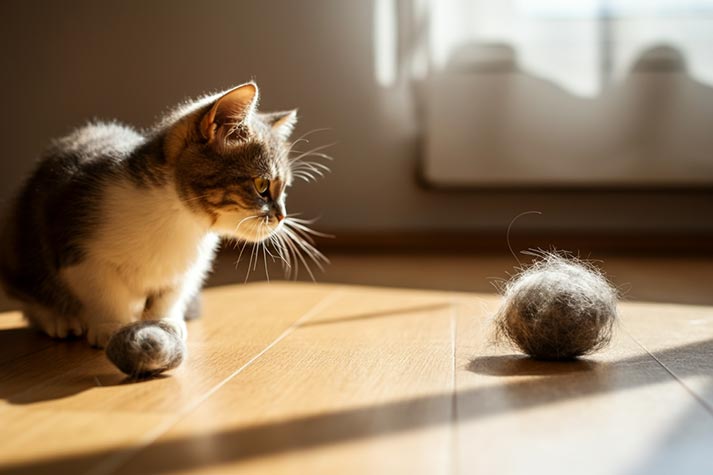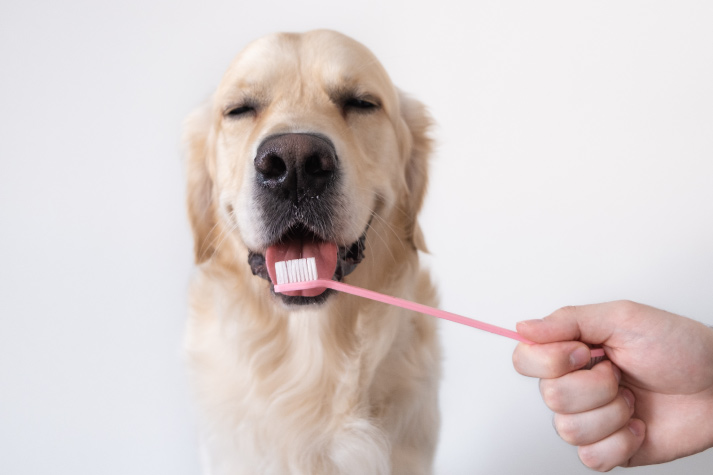
28 May
Cat Hairballs: Where They Come from and What You Can Do About Them
If you share your home with a cat, you have likely witnessed the familiar scene: a sudden pause in playtime, a strange guttural noise, followed by your cat coughing up a small, soggy mass of fur on the living room floor. While hairballs are not very pleasant to look at (or clean up), they are a routine part of feline life.
For many pet parents, however, the question remains: why do cats get hairballs, and how much is too much?
Here’s A Closer Look at What Causes Hairballs
What Are Hairballs
At its core, a hairball is just what it sounds like: a ball of hair. Cats are meticulous groomers. They spend a significant portion of their day licking their fur, not just to stay clean, but also to regulate body temperature and reduce stress. This grooming behaviour is deeply instinctual.
If you have ever been licked by a cat, you know their tongues aren’t soft and smooth. Instead, they are covered in tiny hook-like structures called papillae. These barbs are ideal for detangling fur and catching loose hairs, but they also trap those hairs on the tongue, which your cat then swallows.
Most of the time, the ingested fur passes through the digestive tract and is eliminated in the litter box. But sometimes, especially with long-haired breeds or during seasonal shedding, the fur accumulates in the stomach instead. Over time, it forms a compact clump that your cat is unable to digest. That clump then needs to come back up the way it came in.
What Does a Hairball Episode Look Like?
When a hairball is ready to be expelled, your cat will usually start coughing, gagging, or retching. This is often accompanied by a hunched posture, extended neck, and a bit of dramatic flair that may alarm first-time cat owners. Eventually, they will vomit up the hairball, usually along with a bit of stomach fluid.
It is not pretty, but it is certainly necessary. While a single hairball is not cause for concern, frequent hairball episodes could point to excessive grooming, a high-shedding coat, or a digestive issue that prevents hair from moving through the system properly.
How to Prevent Hairballs
You cannot stop your cat from grooming, and you should not try to. But you can reduce the amount of loose hair they swallow, and that remains the most effective way to cut down on hairball formation.
- Brush Your Cat Regularly - Especially for long-haired breeds like Persians, Ragdolls, and Maine Coons, daily brushing is essential. Even short-haired cats benefit from a few grooming sessions each week. The goal is to remove as much loose fur as possible before your cat does it themselves with their tongue.
- Use the Right Grooming Tools - Fine-toothed combs and de-shedding brushes can reach the undercoat and help groom fur that basic brushes miss. Invest in quality grooming tools designed for your cat’s specific coat type. The fewer stray hairs they swallow, the better.
- Consider Hairball-Control Foods and Treats - Many pet food brands offer special formulas designed to reduce hairball formation. These foods typically contain more fibre, which helps move hair through the digestive tract more effectively. Some also include natural lubricants, like fish oil or beet pulp, to ease passage.
- Keep Your Home Environment Low-Stress - Stress can lead to excessive grooming, which in turn leads to more hairballs. If your cat seems to be licking obsessively, especially during changes in their environment, try to create a calm, predictable routine. Interactive toys, scratching posts, and designated hideaways can help.
Don’t Forget to Hydrate
Water is often the unsung hero of digestive health. A well-hydrated cat is more likely to pass ingested hair through the digestive system without issue. Make sure fresh, clean water is always available. If your cat prefers running water, consider investing in a pet water fountain.
Keep an eye on the water bowl, especially if your cat has long fur. Some cats, like Persians, tend to shed into the bowl or even nap beside it. Regularly clean and refill it to keep it free of fur and debris.
When to Call the Vet
Hairballs are common, but that does not mean they should be ignored. If your cat is frequently retching without producing a hairball, seems lethargic, loses their appetite, or has trouble defecating, it could be a sign of a blockage. Intestinal obstructions caused by compacted fur can be serious and may require veterinary intervention.
Even if there is no emergency, frequent hairballs are worth discussing with your vet. They might recommend dietary changes, supplements, or further testing to rule out underlying gastrointestinal issues.
Final Thoughts
Cats, with all their grace and mystery, come with their own set of peculiar habits. Grooming (and the occasional hairball) is just one of them. As pet parents, our job isn’t to eliminate these quirks, but to manage them in a way that keeps our furry friends comfortable and healthy.
By brushing your cat regularly, offering the right diet, ensuring they stay hydrated, and staying alert to changes in their behaviour, you can keep hairballs from becoming a recurring issue. Think of it as part of the contract of companionship: you care for them, and they repay you in affection, curiosity, and more than a few memorable moments.
Yes, hairballs are messy, and they can be a little gross. But they are also a small price to pay for life with a cat; quirks, coughs, and all.






AUTHOR’S BIO
Carry My Pet
Passionate pet enthusiasts and globetrotters, dedicated to easing furry friends' journeys worldwide. Penning tales of compassion at CarryMyPet, where every relocation is a tail-wagging adventure.